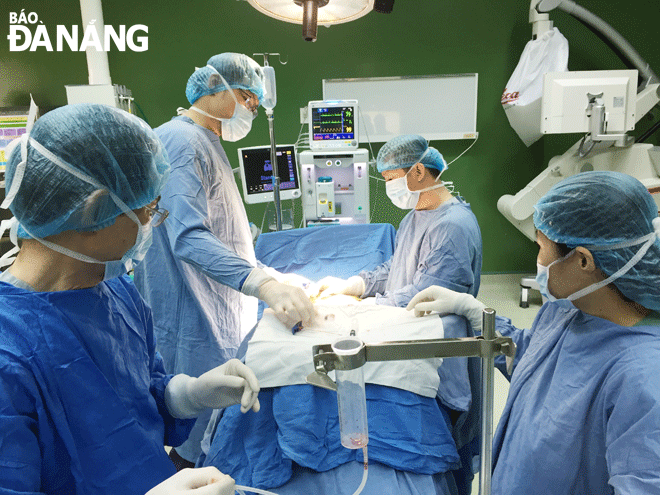Da Nang eyes towards diversity in healthcare
In order to effectively implement Resolution No. 15-NQ/TW of the Party Central Committee on some social policy issues for the 2012-2020 period, Da Nang’s health sector has focused gradually improving locals' physical strength and improving the nutritional status of children. Thanks to this, the indicators on population and healthcare associated with the city's socio-economic development targets have significantly contributed to improving residents' health.
 |
| Surgeons from the Da Nang Hospital performing a bone marrow transplant surgery due to a spinal injury for a patient. Photo: PHAN CHUNG |
One of the bright spots in the city’s current health policies is the implementation of universal health insurance.
Accordingly, the universal health insurance plan is developed and implemented to wards, communes, residential groups, and villages, in accordance with the characteristics of the actual situation in each unit and locality.
In 2021, 97.5% of the city’s population was covered with health insurance, an increase of 6.53% compared to 2012, and 10.2% higher than the rate of national health insurance coverage.
When health insurance coverage is expanded to people from all walks of life, they receive health care right from the grassroots health care level and with better medical services.
According to Dr. Tran Thanh Thuy, Deputy Director in charge of the municipal Department of Health, health programmes and projects to support special and disadvantaged people are deployed appropriately in each phase. In which, health-population target programmes and activities have been fully and effectively carried out.
Through these activities, the local health sector has boldly deployed many good healthcare models in the locality, including the community-based non-communicable disease management model, and basic medical model according to the principles of family medicine.
At present, 100% of wards and communes in the city are able to manage and treat non-communicable diseases such as diabetes, high blood pressure, chronic obstructive pulmonary disease, bronchial asthma, and psychosis.
Many models have been promoted and implemented over the past time and left an impression on people, including children's 1,000 golden days, and encouraging mothers to exclusively breastfeed their babies for the first 6 months.
Moreover, the city’s health sector cooperates with many domestic and foreign organisations to deploy communication activities in health centers and stations to educate health-related information to mothers of child-bearing age, said Dr. Thuy.
In order to develop a diversified and flexible healthcare service system in both quality and quantity in the direction of professionalism, the city has gradually carried out policies on financial autonomy and socialization, aiming to widely mobilise resources for its healthcare sector.
According to the roadmap of financial autonomy mechanism issued by the Government in Decree No. 16/2015/ND-CP (dated February 14, 2015), up to now, the city's health sector has temporarily classified and gave autonomy to 23 public non-business units. Of which, 5 are given autonomy to decide on their use of revenue, the level of salary payment, or how much they spend on investment, procurement, investment and development funds or support funds for poor patients. 15 are self-financed with part of recurrent operating expenses, and 3 are fully covered by the city’s budget.
The classification as a self-financed unit for recurrent expenses has helped the units improve their autonomy in performing tasks, organisational structure, and autonomy in personnel and finance. This motivates the units to operate in an increasingly efficient manner, thereby diversifying products to satisfy patients’ needs.
Dr. Thuy, however, stressed the need for the city to soon issue policies to attract, and incentives and specific regimes to the medical workforce at the grassroots level.
Reporting by PHAN CHUNG - Translating by M.DUNG